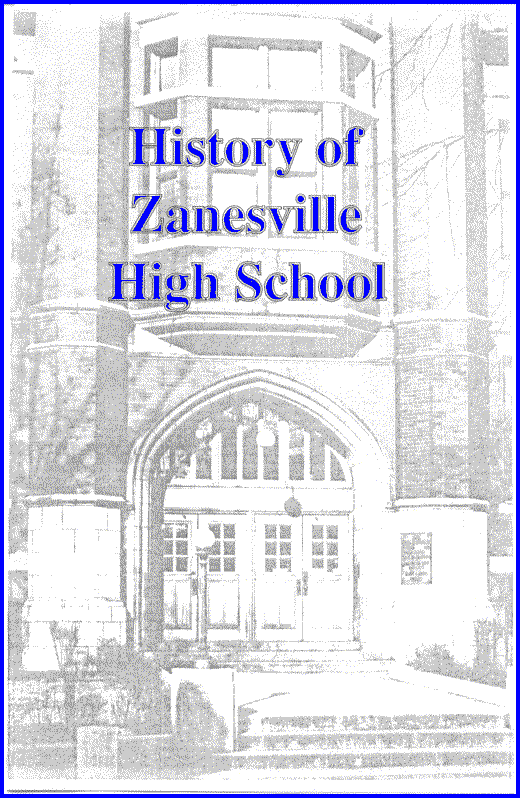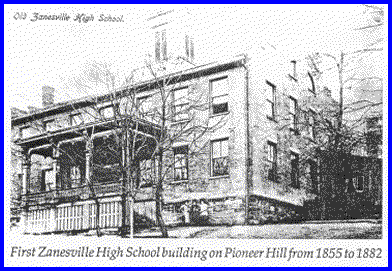When Zanesville High School graduates saw workmen demolishing the Lash building in1986, they felt sentimental about their alma mater. Some begged bricks from the workmen as mementos. A few stole bricks at night. Others bought bricks with a a picture of the school glued on the top. The Lash building, which faced Shinnick Street between Fifth and Sixth streets, was named after a former superintendent of schools. It was the third home of Zanesville High School.
The city's first high school opened its doors in 1855 in a former grade school building on Pioneer Hill. Zanesville had considered the establishment of a high school for several years. Private teachers had conducted English and classical high schools for which they charged tuition. Demand for a public high school was increasing. A taxpayer wrote a letter to the editor of The Courier on July 19, 1852, complaining that the city had two prisons but only one school. Taxation for schools in Zanesville increased from $9,431 in 1853 to $17,000 in 1858. Limited funds were available for schools.
In 1852 the board of education, council and the McIntire fund directors met and adopted resolutions that the city authorities take measures to procure from the McIntire estate the grounds later occupied by the second and third high school buildings. It was proposed that the remains of John McIntire be removed to that site and a suitable monument be erected. This plan was never carried out.
When Zanesville High School opened its doors in 1855 in a former two-story, brick grade school on Pioneer Hill, fifty students were enrolled. It was built in 1849 at a cost of $3,759. For several years grade school boys attended the new Hill School and girls went to a school on Seventh Street. Janitors lived in both buildings to prevent fires.
The board of education decided in 1852 to convert the Hill School to a high school, but the change was not made until April, 1855. The first graduating class of three students received their diplomas after a two-year course in 1857. Early commencements were held in Nevitt's Hall (third story now removed), a building at the northwest comer of Main and Seventh streets; Odd Fellows Hall; and Black's Music Hall on the south side of Main Street between Third and Fourth streets.
The curriculum at that time was not easy according to the superintendent's report for 1860. It included natural philosophy, physiology, geology, intellectual philosophy, logic, astronomy, geometry, trigonometry, mensuration and more common courses.
Students of that period aimed at high standards. Several copies of a remarkable Z.H.S. publication are preserved at the Ohio Historical Society in Columbus, Ohio. The pioneer publication was a four-page magazine called The Eaglet. The Zanesville City Times of January 24, 1856, said: "The Eaglet is the euphonious title of a neat little monthly issued in this city by the pupils of Zanesville High School, and made up entirely of original matter. It is certainly a very readable affair." It was written by the Repartee and Scroll clubs of the high school.
The schedule did not consist of all work and no play. In the late 1920's, former students gave interviews to reporters of The Zanesvillian, a weekly high school paper. They told that boys bored a small hole in the water pipe behind the teacher's desk, tied a cord to a plug and pulled it to spray the teacher. They also concealed a dog in the stove. The teacher heard the barking but he could not locate the dog. When the teacher reprimanded boys for spitting tobacco juice in their ink wells, one boy retorted, "You swallow your spit." Another graduate of the Hill School recalled that a teacher told a boy to leave the room. The boy replied, "You don't think I'd take it with me, do you?"
The Z.H.S. boys did not know that Ralph Waldo Emerson " lectured on "Manners" at I.O.O.F. Hall in 1860. And they probably had not read his poem, Voluntaries, but by their actions they proved the truth of his lines:
"So nigh is grandeur to our dust,
So near is God to man,
When duty whispers low, 'Thou must,'
The youth replies, 'I can.' "
When the call came in 1861 for volunteers for the Union Army, there were nine boys in the senior class of Z.H.S. All nine marched down Main Street and enlisted.
Mrs. F.A. Nevitt of the class of 1865 recalled that the students could take a four or five year course at that time. Students assembled for group singing daily, and compositions were due every Friday. In 1861 Z.H.S. graduates held a reunion at the school. Two hundred people were present.
Returning Civil War veterans brought the game of baseball to Zanesville High School. Boys quickly laid out diamond in the old cemetery near the school. They used grave markers for home plate and bases. Only the grave of John McIntire was not desecrated, because the executors of his estate preserved it.
McIntire's town did not extend across the Muskingum River. The enrollment of Zanesville High School increased in 1873 by the merging of the Putnam and Zanesville high schools. The rivalry between the towns had been long and bitter. Zanesville settlers from the South feuded with the New Englanders in Putnam over securing the state capitol and abolition of slavery. Putnam stubbornly rejected annexation to Zanesville for many years. But finally the need for fire protection forced the proud Putnamites to accept annexation in 1872. The two high schools held a joint commencement in Black's Music Hall.
The last class of eighteen students graduated from Z.H.S. on the hill in 1882. The enrollment had increased from fifty students in 1855 to 200 in the last year. In this period a third year was added to the course. The number of teachers had increased from two to five. Miss Margaret Stultz, the only woman principal in the history of the school, served from 1869 to 1871.
A boy in the last graduating class at the school on Pioneer Hill liked to entertain his classmates by singing and dancing. The subject of his commencement essay was P.Y.O.C. (Paddle Your Own Canoe). He paddled his own canoe to success as a singer and actor. You may have heard his voice.
Otis Harlan spoke the part of Happy in Snow White and the Seven Dwarfs.
When the Putnam High School students moved to Z.H.S. the old building on the hill was overcrowded. The board of education paid $35,000 to the executors of the McIntire estate for a location for a new three-story school. The lot was bounded by North Street (now Shinnick), Sixth Street, Elberon on the north and an alley on the east. This school was built at a cost of $37,191.36. The high school classes occupied the second and third floors, and grade school classes met on the first floor. English, Latin and business courses were offered in the high school. This is the building that was later occupied by Hancock Junior High School and now houses the offices of the board of education.
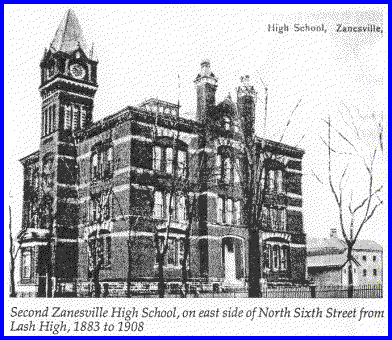
The first graduating class of thirty-three students held commencement exercises in the Schultz Opera House on North Fifth Street. Each graduate gave an oration or read an essay on American literature. In 1888 a fourth year was added to the high school course, and there were only sixteen graduates. As the number of graduates increased, it became necessary to have both afternoon and evening commencement programs. Then in 1895 the board of education limited the number of orations to nine. Three were selected by the principal, three elected by the class and the remaining three were the graduates with the highest grades. The enrollment increased from 200 to 499 during the twenty-four years m the second building.
Several traditions originated there. One of the first clubs was the Phildigill Club, organized in 1889. In the same year the students produced the first class play, 5he Stoops To Conquer. Two literary societies, the Agora and the Athenian, were organized in 1900.
Comus was one of the traditions that originated in the second building. Miss Zella Harris of the class of 1897 visited friends in Toledo. There she saw a school paper. She presented her suggestion for a school magazine to the senior class. Corydon Haddox moved that the class adopt the idea.
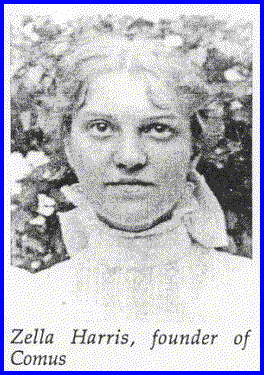 Who named the magazine? Many years ago Roy Jordan, Sr., the first business manager of Comus, was asked that question. He thought that David Leroy Ferguson selected the name. David, a black boy, was admitted to membership in the St. James Episcopal Church and became a minister. When located about forty-five years ago in Boston, where he was pastor of a church, Rev. Ferguson could not remember naming Comus. But he did recall that he had written a poem entit1ed "Comus" for an early number.
Who named the magazine? Many years ago Roy Jordan, Sr., the first business manager of Comus, was asked that question. He thought that David Leroy Ferguson selected the name. David, a black boy, was admitted to membership in the St. James Episcopal Church and became a minister. When located about forty-five years ago in Boston, where he was pastor of a church, Rev. Ferguson could not remember naming Comus. But he did recall that he had written a poem entit1ed "Comus" for an early number.
At that time and for many years later, a book entitled Milon's Minor Poems was required reading. It contained "Comus, a masque." Comus was the god of revelry. The first issue was published by the senior class in December, 1896. Later, Comus became a literary monthly with some news and humor. The art department made cover designs for each issue.
The school colors, blue and white, also originated in the second building. Reference was made to the high school colors in the commencement number of Comus, May, 1897. In that year they consisted of one and one-half inch ribbons. Colors were distributed on April 28, 1897. Because of the great demand, it was found necessary to order fifty yards more. The ribbon was a very fine quality silk, and was an exact shade of Yale blue. The faculty decided to make inch and a half ribbon the uniform width.
Z.H.S. boys played their first football game on the old Lash school lot. The city block across Sixth Street to the west was owned by the McIntire estate. In his will John McIntire, founder of Zanesville, provided for a free school for his town. Completed in 1835, it stood on the southwest corner of the square. After tax-supported public schools became available parents refused to send their children to a charity school. The Academy was used as a city grade school building until it was demolished in 1906. The east end of the block was vacant.
The Courier of November 2, 1889, said, "The board of education had granted to the boys of the high school permission to use the McIntire school yard as a football grounds. Yesterday the boys erected goals and divided themselves into two clubs. Rich sport is anticipated, and no doubt the clothing and doctor business will become lively as torn clothes and skinned shins go hand in hand with football."
In a few years the players hosted teams from other institutions. The Signal said on December 2, 1895: "The so-called game of football at Gant Park (on West Main Street) yesterday afternoon between the Zanesville Athletic Club and the Muskingum College team from New Concord, was begun at 3 o'clock. After wallowing around in the mud on the Zanesville end, the players ended the game with Muskingum 34 and the Zanesville Athletics 0."
Then, as now, eligibility was a factor. The Courier said on April 26, 1902: "When the High School Athletic Association was organized, the faculty gave it all possible encouragement. It was found, however, that some of the most successful athletes were disposed to neglect their scholastic courses in the interest of their play. Because of this fact, several games that might have been won have been lost, much to the chagrin of the athletes."
The Times Recorder said on August 3, 1905, that the high school had not had a football team for a number of years. Interested boys planned to organize a team. One hundred members of the Z.H.S. Athletic Association paid dues of twenty-five cents annually. Principal Hoskinson planned to buy uniforms with the money. Al Evans had played football at Z.H.S. in 1901 and 1902. He developed his football skills at Ohio Wesleyan University and returned to Z.H.S. as the first professional coach in 1906.
The Z.H.S. basketball tradition also originated in the second building. In 1906 the local basketball team won the state championship. The basketball enthusiasts played several games in the Polo Rink, later the Palace Garden on South Sixth Street. Then the team moved to the armory of Company A on the first floor of Memorial Hall on North Fifth Street. After that, games were played across the street in Gold Hall (which was designed for a dance hall) in the Schultz Opera bock until the third high school building was completed In 1908. The Z.H.S. girls also played basketball in Gold Hall in 1906.
Near the end of June, 1905, civil war broke out between the ten senior boys and the administration. The boys decided they would wear white trousers which cost ninety cents a pair at commencement. There was no objection to that. But then the junior boys announced that they also would wear white trousers. The senior boys asked the faculty to forbid the juniors from imitating them. No support there. Then they appealed to the highest authority, Superintendent Lash. He also refused support. Only one choice remained -- secession. The senior boys did not attend I commencement. They published a magazine Called Komus with a black cover. In an editorial they characterized Superintendent Lash as "old and childish." Two earlier underground magazines had been published before Komus. They were The French Dancer (date unknown) and The High School Missive in February, 1905.
Many graduates in the history of Zanesville High School attained prominence in the state and in the nation. To list a few wou1d be invidious. But the two most prominent deserve mention. Zane Grey was born in 1872 in a house that is still standing at 705 Convers Avenue. He attended Moore School at Amelia and Park streets. He was more interested in shooting squirrels in Brush's woods (north of the Zane . Market on Adair Avenue) and fishing at Dillon Falls than in school subjects. When he attended Z.H.S. there were two baseball teams, the Gentlemen and the Roughnecks. Zane played with the latter until he dropped out of high school.
When his father, a dentist, moved the family to Columbus, Zane continued to play baseball. His proficiency in that game won him a scholarship in dentistry at the University of Pennsylvania. After graduation he opened a dental office in New York City. In his leisure time he wrote Betty Zane, a novel about an ancestor. Later he became fascinated by the history of the West and wrote Riders of the Purple Sage. That was the first of many western novels that made Zane Grey one of the most popular fiction writers in the world.
Ralph Mershon thought his English textbook contained errors. He dropped out, tutored with Superintendent Lash and went to Ohio State University. After graduating with the first class in electrical engineering in 1890, he became world famous in his profession. He willed eleven million dollars to O.S.U., one-half the income to be used for military training and one-half for general use, but not one cent for intercollegiate athletics. A large auditorium on the university campus bears his name.
Early in the twentieth century Zanesville population had increased, and the second building could no longer accommodate lower grades on the first floor and the high school on the upper floors. The board of education paid to the executors of the McIntire estate $25,000 for the tract bounded by Sixth Street, North (now Shinnick) Street, Fifth Street and Center (now Elberon) on the north. The McIntire Academy was demolished in 1906 to make room for a new high school. The new building cost $130,000.
It was designed by a local architect, Harry C. Meyer, in modified English collegiate style. The new high school faced North Street and extended from Fifth Street to Sixth Street. Local firms had contracts for all the construction work. The. Mosaic Tile Company furnished the floor tile. The brick was made at the Ohio Press Brick Company.
The new high school was opened for public inspection on January 2, 1908. Crowds admired the rooms and equipment. The building contained eighteen classrooms and five recitation rooms, a library, a small assembly room and an auditorium with 1,000 seats. The board of education moved its office to the first floor. The basement contained three rooms for girls' cooking classes, lavatories for boys and .. girls, chemistry laboratory, physics laboratory and a large room for bicycles. The building was dedicated that evening.
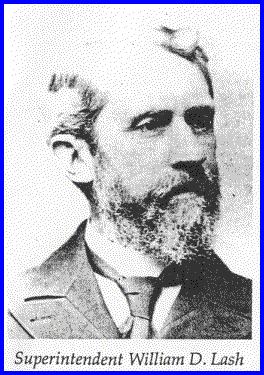
The printed program included several musical numbers, address by Honorable Edward S. Jones, state commissioner of education, and acceptance by Isaac Humphrey, member of the board of education.
The school building was named for Superintendent William D. Lash. He was born in Athens County, Ohio, in 1836. He received a bachelor's degree from Ohio University in 1871, and in 1878 was elected superintendent of schools in Zanesville. Superintendent Lash died on November 24, 1909. The Courier said on December 3, 1909, that the board of education had named the new building Lash High School in his memory. The community placed a bronze memorial plaque on the wall inside the entrance. It contained a likeness of Lash and this inscription: "In loving memory of William D. Lash, 33 years superintendent of public schools, Zanesville, Ohio." The institution remained officially Zanesville High School.
The tradition of leaving class memorials started early at Lash. The class of 1910 left statues of Diana, Minerva, Sophocles and Hermes. Furniture and equipment for the auditorium stage were furnished by the classes of 1912, 1916, 1919 (a grand piano), 1929, 1930 and 1931. The class of 1913 left the electric light posts at the entrance. The useful clock system was bequeathed by the class of 1915. The statue of Theodore Roosevelt was the gift of .the class of 1924. It is now in Theodore Roosevelt Junior High School. The class of 1938 donated the public address system. Older alumni will remember the frieze across the auditorium entrance. It was a copy of the frieze on the west front of the Parthenon. It was damaged by a leaking roof, and the McIntire Library has preserved it.
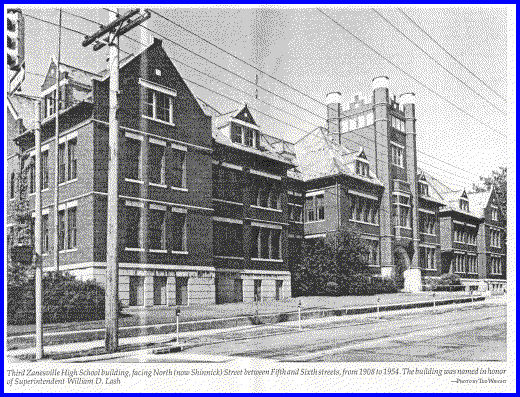 Two years after the new building opened, seniors went on strike. It would not be worth mention except for the fact that it concerned caps and gowns. At that time girls from prosperous families wore a different dress and hat for each graduation event. Three dresses and hats were required, one for class day, one for graduation and one for the class sermon. It was also the custom for girls to carry expensive bouquets. These expenses included gloves, $3; hats $7 to $10; shoes, $4; dresses, $15 to $20. Girls from poor families could not afford those prices.
Two years after the new building opened, seniors went on strike. It would not be worth mention except for the fact that it concerned caps and gowns. At that time girls from prosperous families wore a different dress and hat for each graduation event. Three dresses and hats were required, one for class day, one for graduation and one for the class sermon. It was also the custom for girls to carry expensive bouquets. These expenses included gloves, $3; hats $7 to $10; shoes, $4; dresses, $15 to $20. Girls from poor families could not afford those prices.
To remove all embarrassment for girls who could not afford expensive clothes, the board of-education provided caps and gowns that cost $1.46 each from the A.E. Starr Store. You would think that seniors would welcome traditional academic garb. No. They paraded up and down Main Street in their caps and gowns. The Times Recorder said: "Arrayed in the new regulation regalia the members of the graduating class of the high school paraded the streets of the downtown district last night, creating intense excitement along the line of march. The girls carried banners reading 'Dressed by the board of education' and 'What do you think of the latest?' The senior boys marched behind an impromptu band playing 'There'll be a hot time in the old town tonight.' Then the seniors attended a vaudeville show at the Orpheum Theater on North Fourth Street (now the Business Equipment Company)."
Students attended Lash High School without the convenience of school busses. A member of the class of 1913 recently recalled that she walked and carried her lunch from the Westview area. Students also walked to Lash from Putnam and Brighton. Others rode street cars until they were replaced in 1930 by busses. As years passed, the parking problem for teachers and students became more and more serious.
Students organized new activities in the Lash building. In 1909 they began annual triangular debates with Newark and Mt. Vernon high schools. Two teams, affirmative and negative, worked for months each year to prepare for the annual debates. For several days before each contest, students met in two short pep assemblies every day to generate enthusiasm. They sang debate pep songs from printed folders. Students wrote original debate lyrics to popular songs of the day including "Japanese Sandman" and "Let the Rest of the World Go By." When Zanesville debate teams won, bonfires mysteriously blazed on the courthouse esplanade.
By the 1930's, debate enthusiasm had been diverted to football and basketball. After Lash High School was built, football teams played at Gant Park, Pastime Park on West Main Street, the Fair Grounds and Mark Park on lower Putnam Avenue. After the Municipal Stadium on West Main Street was completed in 1940, games were played there. In the first game at Municipal Stadium, Zanesville played against New Philadelphia. The Zanesville coaches were John Brammer, Bill Zink, and Jim Burrier. Woodrow Hayes coached the other team. The score was Zanesville 26, New Philadelphia 13.
Students called their athletic teams Blue Devils in the early 1920's. There is no record of the origin of the name. It included one of the school colors, not otherwise used except in the alma mater. One superintendent objected to the name Devils. He persuaded the school to adopt Blue Spartans. But when he left, they returned to the use of the Blue Devils name. Howard Rarick compiled a complete illustrated history of Z.H.S. football from 1901 to 1981. The Zanesville Athletic Boosters published the book in an edition of 1,000 copies in 1981. A similar history of Z.H.S. basketball should be compiled.
The monthly Comus magazine increased in size in the new building. Gradually it .contained less humor and fewer original Eng1ish compositions. The editors devoted more space to news, sports and alumni. The printing cost was defrayed by advertising from local merchants. Art students made the covers. In 1917 Andrew Loomis designed covers of professional quality. Later he became a nationally known commercial artist. The last issue of the year was enlarged and became the school's yearbook.
In 1925 the faculty advisor of Comus resigned and the duty was assigned to a young English teacher. He suggested, that in order to avoid the burden of compiling the yearbook in the last month of the school year, a separate staff should be selected for the Comus annual and a second staff for a weekly newspaper to be called The Zanesvillian. It was published for five years. Then local merchants could no longer afford to advertise during the Depression, and The Zanesvillian appeared weekly in The Sunday Times Signal until 1970.
One morning in the early1920's, the students found their desks empty. A search discovered all the textbooks in the school stacked in a shoulder high mound among the seats at the back of the auditorium. Who? Why? Perhaps there are grandfathers now living in j Zanesville who know the answers. The principal, George Bowman, called the shocked students to an assembly, made some solemn comments and dismissed them. At that time, 1 students owned their own textbooks.
In the same period, three high school fraternities had 1 clubrooms in downtown Zanesville. They had no official connection with the school. They were Phi Sigma Chi, Phi Delta Kappa and Alpha Pi. School authorities suspected that they knew something about stacking the books.
A new tradition originated in the fa11 of 1921. Martin Mansperger, the new principal, said at the end of the first assembly, "Now sing your alma mater." When told that the school did not have one, he said, "Sing that last song again. It will be your alma mater." It was "Zane, Zanesvillians, see how they cheer, ever victorious, year after year," by Bernard Mechling. After the assembly an English teacher reminded Mansperger that an alma mater should be more solemn. The principal asked, "What would you suggest?" The teacher replied, "That other song by Bernard, 'Dear old Zanesville High we love you.' " "All right," Mansperger replied, "that will be the alma mater of Z.H.S." Mechling was a gifted musician and poet. He became manager, vice. president and director of Zanesville Theaters, Inc.
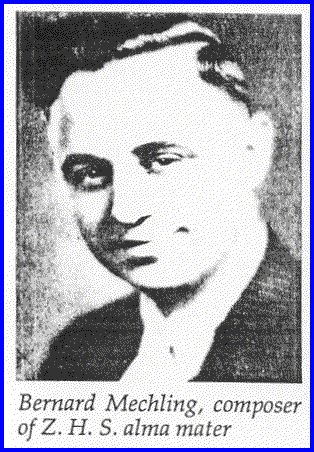 Students organized many extracurricular activities in the 1920's. Debate teams have already been mentioned. Among those listed in a school handbook were Hi- Y Club, IFKA Cub, Torch Club, D.O.Z. Club (Daughters of Zeus), Long- fellows Club, Glider Club, Glee Club Operetta, Athletic Aides and Letter Club. Juniors and seniors presented class plays every year. The music department conducted both a band and an orchestra.
Students organized many extracurricular activities in the 1920's. Debate teams have already been mentioned. Among those listed in a school handbook were Hi- Y Club, IFKA Cub, Torch Club, D.O.Z. Club (Daughters of Zeus), Long- fellows Club, Glider Club, Glee Club Operetta, Athletic Aides and Letter Club. Juniors and seniors presented class plays every year. The music department conducted both a band and an orchestra.
The number of clubs increased in the next thirty years. The building was centrally located, and public transportation was available after school hours. These extracurricular activities were listed in the 1954 Comus: Leaders Club, Discussion Group, Mimeographers Club, Safety Patrol, Movie Operators, Varsity Cheerleaders, National Thespian Society, View Finders, Radio Engineers, .College Club, National Honor Society, Junior Red Cross, Friendship Club, Daughters of Zeus, Office Aides, Girls Athletic Club, Hi- Y, IFKA, Future Teachers and Blue and White Club.
Enrollment increased rapidly in the first fifteen years at Lash. The attic was inadequate for gym and basketball. In 1923 plans were made for an addition on the northeast corner of the building. During construction many students were on half-day schedules. The new addition provided a gymnasium and rooms for cooking, sewing and art. These improvements provided facilities for another thirty years.
The Lash auditorium with 1,000 seats was adequate for commencement programs until the late 1920's. Then graduation programs were held in Memorial Hall on North Fifth Street until it was condemned in 1937. In that year the seniors received their diplomas in the Market Street Baptist Church, and in 1938 and 1939 the graduates and their families went to Coburn Methodist Church on West Main Street for graduation programs. In 1940 the Municipal (now Secrest) Auditorium was completed and used for commencement until the last class graduated from Lash in 1954.
Z.H.S. students and faculty loyally supported the armed forces in World War II. Eight teachers were called to military duty. Students cooperated in all defense projects. Many alumni served heroically. One received national recognition. Lieutenant Osborne B. Wiseman, a Z.H.S. graduate of the class of 1932, was a bomber pilot. At the battle of Midway he took off from the carrier Yorktown and dropped a bomb on a Japanese ship. When he returned to the Yorktown, it was listing. Lieutenant Wiseman found another U.S. carrier, landed and waited to have his gas tank and bomb bay filled. While waiting he said, "I hope I can do that again." He was shot down in his next dive. In his honor the Navy named a ship the U.S.S. Wiseman.
The school emphasized practical methods. Every year seniors took over the city offices for one day to learn about municipal government. On May 19,1948, they led police to raids on three gambling joints where "cookie jars" were found. One man pleaded guilty and was fined $25 and costs. The local paper said: 'The boys stirred up a hornet's nest, and the hissing is still being heard all the way from New York to Kansas City." After that experience the boys returned to their textbooks.
Ten years after the addition was built, the need for a larger building became more urgent every year. Built for 850 students, it registered 1,165 in 1948. The first graduating class in 1908 contained 54. The graduating class of 1951 with 371 members was the largest in the history of Z.H.S. The last class to graduate from the Lash building in 1954 contained 328. In the last year at the Lash building, the faculty included fifty-one teachers and four administrators.
As early as 1935, school authorities submitted a bond issue for a new high school. In the midst of the Depression, voters failed to approve a bond issue of $455,000 that would have been matched by Federal appropriation. Again in 1941 voters rejected a bond issue of $2,775,000. It failed by only 171 votes to receive a two-thirds majority. The vote was 7,401 for and 4,247 against, a favorable vote of 63.54 percent when 65 percent was required. Students wore black arm bands to express their disappointment. They staged a demonstration, and a mass meeting was called by public demand for the school board to submit the issue again before the end of the year.
Accepting the mass meeting as a public mandate, the board placed the bond issue before the voters again on December 27. That date was less than three weeks after the attack on Pearl Harbor. It was defeated by only fifty-four votes. The requirement for two-thirds approval was an obstacle that was almost impossible to overcome.
A rescheduled bond issue for $2,775,000 was placed on the ballot November 6, 1945. An architect drew plans for a building facing Linden Avenue near Ball Street. It was to be named the Zanesville Memorial High School in honor of the Zanesville service men who died in World War II. Two football fields and recreation areas extended to the Muskingum River. The vote was 7,277 for and 4,231 against, short 204 votes of 65 percent. Students left their classes and demonstrated on Main Street against the defeat. A fifth bond issue for $2,775,000 was submitted on November 2, 1948. It passed by a margin of 301 votes, or 66.8 percent. After a decade of effort by thousands of citizens, funds were finally available for a new high school building.
Next came the choice of a site. At a mass meeting in the Lash auditorium on November 4, 1948, citizens proposed several locations. One resident of Blue Avenue urged that the new school be built on Mill Run Road. Others suggested Putnam Hill Park and McIntire Park. Several of those present advocated two high schools, one north and one south. The Fair Grounds and the former Mark Manufacturing Company site in lower Putnam were also proposed. An article in The Times Recorder recommended the McIntire Childrens' Home site on Blue Avenue. That was finally chosen, and all four local high schools occupied land formerly owned by the McIntire estate. McIntire's remains had been moved from Pioneer Hill to the McIntire Childrens' Home grounds on December 24,1889.
The board of education paid the trustees of the McIntire estate $67,000 for the sixty-five acre site. Blue Avenue ended at the site and was extended eventually to Taylor Street. The board chose R. Franklin Outcalt of Cleveland, Ohio, as architect of the new school. The contract for the construction was let to E. Mast and Sons at their bid of $1,600,000. The company began work in July, 1951.
As construction proceeded, it became evident that more funds would be needed to complete the school. On November 4, 1952, voters approved another bond issue of $2,100,000 to complete the new high school and make needed repairs on other school buildings. A 55 percent vote was needed for passage. Voters cast 12,799 votes for and 5,125 against the issue, giving 160 more votes than needed. Wendling Brothers of Dover secured the contract for the auditorium, music wing and vocational arts building.
As work progressed on the new school, many people stopped to inspect the imposing structure. The Jaycees provided a register for the visitors. In October, 1952, newspaper reports said that the register and other records would be enclosed in a time capsule to be buried near the school. It was made of concrete covered with asphalt and painted gilt.
Near the end of the last year at Lash, students had an opportunity to inspect the new school they would attend in the fall. Led by the Z.H.S. band, the students and teachers marched across the old Fifth Street bridge and through the Terrace to the new school. There they were conducted on a tour of the building.
When the members of the 1954 class received their diplomas at the Municipal Auditorium, the history of Z.H.S. in the Lash building ended. The forty-six year old structure served Hancock Junior High School for another thirty years. Hancock Junior High School was established in 1924 In the second Z.H.S. building. The third floor was removed in 1937. During alterations, the junior high was moved to overcrowded Lash. In January, 1938, the Hancock students returned to their reconditioned building. In 1939, two temporary frame school rooms were added on the north side of the building.
When the new building on Blue A venue opened in 1954, Hancock Junior High School moved across North Sixth Street and occupied the Lash Building. At the same time the board of education moved its offices from the Municipal building to the former Hancock building. Parking was limited for Hancock. No athletic field was available. The roof, wiring and plumbing were in bad condition. A levy for a new junior high school was not feasible. The board built a large addition to Zanesville High School for the ninth grade pupils of the city in 1986. The Lash building was vacated in 1984 and demolished m 1986. An attempt was made m 1983 to convert old Lash into a downtown mall to be called Zane's Place. Council appropriated $75,000 for planning and promotion. The plan failed to attract renters.
McIntire Library is located on the northwest corner of the former Lash block. In 1978 the library purchased the Big Bear property on Fourth Street for future use. In 1985 the Library board and the Zanesville board of education exchanged properties, giving the Library ownership of the entire block.
 Opening day for the new school on Blue A venue was September 9, 1954. As the day approached excitement ran high among students and the public. The Times Recorder said of the new four million dollar building, "You have to see it to believe it." The students said the new school was "real keen." Authorities expected 1,455 students. The teachers had met in all-day session to prepare for the first day. Instructions had been mailed to students about the location of their homerooms. The building opened at 8 a.m. and classes began at 8:20. The school day of nine periods ended at 3:40. The cafeteria served teachers and students in two lunch periods.
Opening day for the new school on Blue A venue was September 9, 1954. As the day approached excitement ran high among students and the public. The Times Recorder said of the new four million dollar building, "You have to see it to believe it." The students said the new school was "real keen." Authorities expected 1,455 students. The teachers had met in all-day session to prepare for the first day. Instructions had been mailed to students about the location of their homerooms. The building opened at 8 a.m. and classes began at 8:20. The school day of nine periods ended at 3:40. The cafeteria served teachers and students in two lunch periods.
After twenty-nine years of community effort, Zanesville's fourth high school building opened its doors with 1,400 students and sixty-four teachers. It was considered the most modern and advanced high school building in the nation. The public transit system scheduled busses to transport students. The sixty-five acre tract provided room for parking, tennis and athletic fields.
The completed building was dedicated on May 20,1955. The program included a civic testimonial to the board of education by D. W. Armstrong, member of the citizens' advisory committee; response from the president of the board of education, Dr. Weldon Slater; message from superintendent of schools, Donald F. Summers; presentation of memorial chimes, Mrs. Katherine Bauman Geis; and dedicatory address, Chester H. Lang, vice president public relations, General Electric Company.
For a decade after the Blue A venue school opened, the Blue Devils football team continued to play games at the Municipal Stadium. The John D. Sulsberger Memorial Stadium was dedicated on November 13, 1964. John Sulsberger graduated from Z.H.S. where he was an All-Ohio football player. He was a freshman at Ohio State University on a football scholarship when he was stricken by cancer. He died on December 20, 1963. Funds for the stadium project came from public subscription and the Zanesville Boosters Association, along with the support of Dr. and Mrs. J. Diehl Sulsberger of Dresden Road, parents of the late football star. The dedicatory address was delivered by Mr. Woodrow W. Hayes, football coach at Ohio State University.
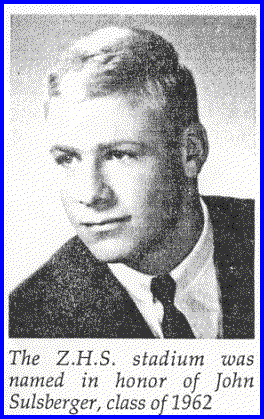 In 1988 a contract was let for $887,805 for an addition to the gymnasium to be completed by November. The renovated facility at Z.H.S. doubles the size of the former gymnasium and will provide additional instructional areas for physical education classes. It will seat 2,700 spectators for athletic events and other school activities.
In 1988 a contract was let for $887,805 for an addition to the gymnasium to be completed by November. The renovated facility at Z.H.S. doubles the size of the former gymnasium and will provide additional instructional areas for physical education classes. It will seat 2,700 spectators for athletic events and other school activities.
The department of vocational training occupied the west wing until 1969. In that year the Mid-East Ohio Vocational School was built on Richards Road. As more students attended that school, space became available for other uses. Today the former vocational wing is used for cafeteria, learning disability, metal and wood-work shops and a darkroom.
The decrease in the enrollment of Z.H.S. on Blue Avenue as compared with the classes at Lash reflects the decline of population in the city. The number of ninth grade students at Blue Avenue is 416, plus six at the Vocational School. The three senior high school classes will be listed with the number of students attending Vocational School in parenthesis and the total class sizes: sophomores, 389 (24) 413; juniors, 262 (45) 307; seniors, 243 (53) 296. That number is considerably lower than the 371, the largest graduating class at Lash in 1951. The faculty includes eighty-six teachers and a staff of administrators. Ten percent of graduates register at two year colleges, and twenty-five percent attend four year colleges.
School starts at 7:15. When students hear the 2:15 dismissal bell, they hurry to thirty-two busses parked in front of the school. The large campus was recently increased from sixty-five to seventy acres. It provides ample parking room for eighty-six teachers and two hundred students, most of whom have permits.
The school publishes a twenty-four page handbook of student information. It includes this statement of the mission of the school: "The mission of the Zanesville city schools is to provide each student with an equal opportunity to attain the highest possible level of intellectua1, personal, social and vocational development." Other topics include: Misconduct Code; Offenses Against People, Pupils and School Personnel; Personal Appearance and Dress; Use of Automobiles; Grade Policy and Procedures; and College Entrance requirements.
In thirty-four years on Blue Avenue, student clubs have changed. In the 1954 Comus twenty-one clubs were listed at Lash. Today on Blue Avenue the yearbook includes these clubs and activities: Comus, ZanesvilIian, Ski Club, Thespians, Quiz Team, Homecoming, Band, Devilettes, Cheerleaders, National Honor Society, Octoberfest, Halloween Dance, Student Council and Choir. This is a small number compared with the many clubs at Lash. One reason may be the fact that students have to hurry to the waiting busses at dismissal. Teachers also named the "tube" as a possible reason.
Several changes have been made in the curriculum. World History in the tenth grade has been abolished. Civics and Health have been added. In the senior year two new courses, Education for Adulthood and Government, are required.
The traditional Comus and Zanesvillian are still published on Blue Avenue. The 1987 edition of Comus contained 262 pages and a supplement of thirty pages for the Prom. It sold for twenty dollars. The ZanesvilIian has been revived as a monthly publication and is now circulating Volume 7. Former staff members will be interested to know that the school publication room is equipped with a telephone and computer.
The seniors have made many changes in commencement week. They discontinued .the baccalaureate sermon. The senior banquet replaced the junior-senior banquet. Graduating classes do not leave memorials as they did at Lash. They have abolished class day, with its will, poem, song, class history and oration. The junior-senior Prom has replaced all of these events. A senior trip has also been added to commencement activities.
Zanesville can be proud of its high school. Graduates occupy positions of responsibility and honor from coast to coast. Unlike the previous sites, the school on Blue Avenue is in no danger of encroachment by business or residences. Future generations will appreciate the support of the voters for the bond issue in 1948 and the planning of the school authorities to assure an ideal site.
To return to the main page, simply close this window..
